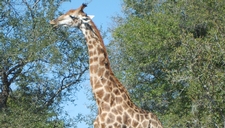Adaptations and Behaviors to Meet Needs of Animals

TEKS Objective
The student is expected to observe, record, and compare how the physical characteristics and behaviors of animals help them meet their basic needs, such as fins help fish move and balance in the water.
Essential Understanding
The student knows that organisms resemble their parents and have structures and processes that help them survive within their environments.
Science Background
Animal Adaptations: Utah Education Network (website) - Physical adaptations help animals meet their basic needs and protect them from enemies. Discover how the physical characteristics of animals such as hedgehogs, alligators and lions help them to survive in their environments.
Animal Adaptations
Utah Education Network, www.uen.org
Adaptation: University of California Museum of Paleontology (website) - An adaptation is a feature that is common within a population—both plant and animal—because it provides some form of benefit. This website and its links provide helpful information and lesson plans focusing on evolution and adaptation.
Adaptation
University of California Museum of Paleontology, evolution.berkeley.edu
Signature Lesson
Matchstick Camouflage: The Zoological Society of Milwaukee (website) - Animals often rely on their coloring to hide from predators. Playing this game, students search for colored matchsticks to understand how animals use color to hide from predators. Narrow, colored strips of paper may be used in place of matchsticks.
Matchstick Camouflage
The Zoological Society of Milwaukee, www.zoosociety.org
- Supporting Lessons
- Extensions
- Assessment Ideas
- Literature Connections
- Related
TEKS - Additional Resources
Supporting Lessons
Who Lives Here? Texas A & M University Department of Entomology (website) - Students learn about and describe the importance of adaptations in a habitat, and identify camouflage as an adaptation that helps animals to survive.
Who Lives Here?
Texas A & M University - Department of Entomology, iitc.tamu.edu
Elaboration Lessons and Extensions
Polar Bears versus Penguins - Pole to Pole Learning Resource Guide K- 3: Moody Gardens (PDF) - This activity, on pages 8-9 of the Pole-to-Pole teacher guide, focuses on how polar bears and penguins adapt to the harsh environmental conditions of the Arctic and Antarctica.
Polar Bears versus Penguins
Moody Gardens, www.moodygardens.com
Assessment Ideas
Collector’s Cards: Zoological Society of Milwaukee (website) - Print the animal cards on linked on this page and distribute one card to each student. To assess understanding of how adaptations and behaviors protect animals, have each student explain the information on his/her card to a partner and then list the special physical adaptations of both partners’ animals on a sheet of paper.
Collector's Cards
Zoological Society of Milwaukee, www.zoosociety.org
Literature Connections
What Do You Know about Animal Adaptations? Slade, Suzanne. (ISBN-13: 978-1404241992)
Animal Adaptations for Survival. Rose, Elizabeth. (ISBN-13: 978-1404228177)
What Color is Camouflage? Otto, Carolyn B. (ISBN-13: 978-0064451604)
Additional Resources
Animals: National Geographic Kids (website) - Click an animal’s picture to learn about its special characteristics and behaviors. Website includes videos, maps and printable photos with facts for use in the classroom or home.
Animals
National Geographic Kids, kids.nationalgeographic.com
Animal Behavior and Training: SeaWorld/Busch Gardens (PDF) - Learn about animal behavior and how animals are trained at Sea World through hands-on investigations.
Animal Behavior and Training
Sea World/Busch Gardens, www.swbg-animals.org
Animal Adaptations: The Zoological Society of Milwaukee (PDF) – Pages 2-10 provide useful background information about animal behavior and the training of animals at SeaWorld.
Animal Adaptations
The Zoological Society of Milwaukee, www.zoosociety.org
TEKS Navigation
Grade 2
Need Assistance?
If you need help or have a question please use the links below to help resolve your problem.

Comments